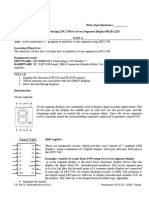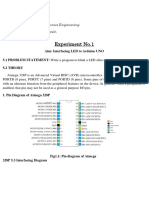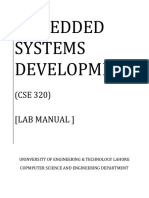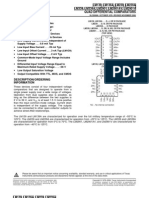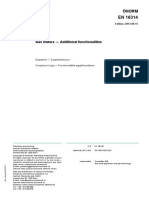Lab 1 Introduction to Assembly Programming Language
Uploaded by
manulaweerarathne.greatviewLab 1 Introduction to Assembly Programming Language
Uploaded by
manulaweerarathne.greatviewEC2132 – Microcomputers
Department of Electrical and Electronic Engineering Year 02, Semester 01
Faculty of Engineering
B.Sc. Eng. (Hons) 2024
Lab 1: Introduction to Assembly Programming Language LO3, LO4
1. Introduction
In this lab, students will learn how to program the PIC16F877A microcontroller using
assembly language. Through simple tasks such as controlling LEDs, integrating input
signals, and simulating the famous "Knight Rider" LED sequence, you will gain practical
experience with basic microcontroller I/O operations. The tasks are designed to develop
both your understanding and technical skills progressively.
2. Objectives
• Understand the basic structure of an assembly language program for PIC
microcontrollers.
• Comprehend the role of each instruction in the program and how they interact with the
hardware.
• Implement simple I/O control by programming the PIC16F877A using assembly code.
• Identify and troubleshoot errors in the simulation and the program.
• Assess the performance of the system with input signals and complex LED sequences.
• Develop and integrate complex control circuits using assembly code.
3. Apparatus
• Proteus simulation software.
• PIC16F877A microcontroller model.
• LED(s).
• Push button and toggle switch components.
4. Laboratory Tasks
Task 1: Lighting an LED
Objective: Program a PIC16F877A microcontroller to control an LED connected to one
of its output pins.
1.1 Turning ON an LED (Output Operation)
• Connect an LED to any one of the output pins of the microcontroller (e.g. PORTB0).
• Write Assembly Code: Write code to turn on the LED.
o Use BSF (Bit Set File) instruction to turn the bit high.
o Make sure to set the corresponding TRISB register for output.
• Simulate in Proteus: Load the hex file and check if the LED turns on.
1.2 Blinking the LED (Timing Control)
• Modify the code to blink the LED with a delay.
o Use CALL DELAY instruction for timing control.
o Create a delay subroutine to control the blink rate.
• Simulate in Proteus: Observe the blinking LED.
Task 2: LED Control with an Input Signal
Objective: Control the LED based on external inputs such as a push button or toggle
switch.
2.1 Using a Push Button to Start the LED
• Connect a push button to one of the input pins (e.g., PORTB1).
• Modify the code to turn on the LED only when the button is pressed.
o Use BTFSS (Bit Test File, Skip if Set) instruction to detect button press.
• Simulate in Proteus: Verify the LED turns on when the button is pressed.
2.2 Using a Toggle Switch to Start and Stop
• Connect a toggle switch to one of the input pins (e.g., PORTB2).
• Write code to turn on the LED when the switch is toggled ON and turn it off when
toggled OFF.
• Simulate in Proteus: Observe how the switch controls the LED.
Task 3: Building the Knight Rider Circuit
Objective: Create a sequential LED pattern using bit-rotating techniques and enhance
control with an input toggle switch.
3.1 Controlling LED Sequences with Bit-Rotating
• Connect multiple LEDs to PORTB (e.g., PORTB<7:0>).
• Write code to create a Knight Rider effect (LEDs light up one after another in a pattern).
o Use RLF (Rotate Left) or RRF (Rotate Right) instructions to create the
sequence.
• Simulate in Proteus: Ensure the LEDs light up in sequence, creating the Knight Rider
effect.
3.2 Integrating the Toggle Switch
• Modify the code so the Knight Rider sequence starts only when a toggle switch is
turned ON.
o Use conditional checks with BTFSS or BTFSC instructions.
• Simulate in Proteus: Check that the sequence only starts when the switch is ON.
5. Post-Lab Questions
1. What is the purpose of the TRIS register in PIC assembly programming?
2. Explain how the BSF and BCF instructions control the output pins.
3. How does the RLF instruction affect the LED sequence in the Knight Rider circuit?
4. How could you modify the code to make the LED blink faster or slower?
5. Discuss potential applications of bit-rotating in real-world embedded systems.
6. Conclusion
This lab introduces the fundamental principles of controlling hardware using assembly
programming for the PIC16F877A. You will learn about basic output control, input sensing,
and sequence generation using LEDs, which are common tasks in embedded systems
development.
You might also like
- Eef368 Microcontroller Lab Manual 2018 2019No ratings yetEef368 Microcontroller Lab Manual 2018 201910 pages
- Tai Lieu Thi Nghiem VXL Top 100 - ModifyNo ratings yetTai Lieu Thi Nghiem VXL Top 100 - Modify33 pages
- Lab 1. A Digital Lock Preparation: Figure 1.1. Texas Io Window Showing The Door Is UnlockedNo ratings yetLab 1. A Digital Lock Preparation: Figure 1.1. Texas Io Window Showing The Door Is Unlocked2 pages
- SOLUTIONS of Ytha Yu Charles Marut-AssemNo ratings yetSOLUTIONS of Ytha Yu Charles Marut-Assem6 pages
- Lab Exercise #1 - Getting Started: Dr. Timber Yuen Rev 0No ratings yetLab Exercise #1 - Getting Started: Dr. Timber Yuen Rev 09 pages
- DP - Unit-4 - BCAIAI507 - (Elective-IV) Embedded SystemsNo ratings yetDP - Unit-4 - BCAIAI507 - (Elective-IV) Embedded Systems7 pages
- AKNM - 6139_labmanual_05_03_18--AKNMGptc_790No ratings yetAKNM - 6139_labmanual_05_03_18--AKNMGptc_79035 pages
- Laboratory Exercise 5 - Peripherals, GPIO (2)No ratings yetLaboratory Exercise 5 - Peripherals, GPIO (2)7 pages
- BME 438 Digital Logic Design and Computer Architecture LabNo ratings yetBME 438 Digital Logic Design and Computer Architecture Lab73 pages
- MCTE 4105 Mechatronics Lab Iii Sem Ii - Session 19/20 Title: Experiment 4: Input Switches and Output LedsNo ratings yetMCTE 4105 Mechatronics Lab Iii Sem Ii - Session 19/20 Title: Experiment 4: Input Switches and Output Leds10 pages
- 23BI14306-Lê Anh Minh-Report of Microprocessor and MicrocontrollerNo ratings yet23BI14306-Lê Anh Minh-Report of Microprocessor and Microcontroller7 pages
- Al Azhar University - Gaza: Microcontroller Report "1" WorkshopNo ratings yetAl Azhar University - Gaza: Microcontroller Report "1" Workshop11 pages
- Dec50122 Embedded Robotics - Pw1 (Procedure)No ratings yetDec50122 Embedded Robotics - Pw1 (Procedure)5 pages
- Course No: MTE 3104 Course Name: Microcontroller & Interfacing SessionalsNo ratings yetCourse No: MTE 3104 Course Name: Microcontroller & Interfacing Sessionals7 pages
- Microprocessor Systems & Interfacing EEE-342: Comsats UniversityNo ratings yetMicroprocessor Systems & Interfacing EEE-342: Comsats University10 pages
- Tutorial 09_Assembler General Questions (LO3 & LO4)No ratings yetTutorial 09_Assembler General Questions (LO3 & LO4)3 pages
- DM7442A BCD To Decimal Decoder: General Description FeaturesNo ratings yetDM7442A BCD To Decimal Decoder: General Description Features4 pages
- Energies: Small-Signal Model and Stability Control For Grid-Connected PV Inverter To A Weak GridNo ratings yetEnergies: Small-Signal Model and Stability Control For Grid-Connected PV Inverter To A Weak Grid24 pages
- Amphneol_01182021_PowerLok_G2_Product_Catalog_2020-1955456No ratings yetAmphneol_01182021_PowerLok_G2_Product_Catalog_2020-195545611 pages
- Board of Radiation & Isotope Technology: Single Copy OnlyNo ratings yetBoard of Radiation & Isotope Technology: Single Copy Only2 pages
- Timers and Time Base Generation: Experiment 10No ratings yetTimers and Time Base Generation: Experiment 107 pages
- Octis Outdoor I/O System: Robust I/O For High Reliability and PerformanceNo ratings yetOctis Outdoor I/O System: Robust I/O For High Reliability and Performance4 pages
- RPS 1000 RPS 2500 RPS 5000 RPS 10000: User ManualNo ratings yetRPS 1000 RPS 2500 RPS 5000 RPS 10000: User Manual49 pages
- Features: 1out 2out V 2IN 2IN+ 1IN 1IN+ Out3 Out4 GND 4IN+ 4IN 3IN+ 3INNo ratings yetFeatures: 1out 2out V 2IN 2IN+ 1IN 1IN+ Out3 Out4 GND 4IN+ 4IN 3IN+ 3IN26 pages
- 50W Mono Low Voltage Amplifier Technical MrigankaNo ratings yet50W Mono Low Voltage Amplifier Technical Mriganka2 pages
- Chapter 8 Solution of Simultaneous Linear EquationsNo ratings yetChapter 8 Solution of Simultaneous Linear Equations59 pages
- Dxx-1710-2690/1710-2690-65/65-18I/18I-M/M-R Easyret Dual-Band Antenna With 2 Integrated Rcus - 1.4M Model: Adu4518R6V01No ratings yetDxx-1710-2690/1710-2690-65/65-18I/18I-M/M-R Easyret Dual-Band Antenna With 2 Integrated Rcus - 1.4M Model: Adu4518R6V012 pages
- GDGK-307 Full-Automatic Circuit Breaker AnalyzerNo ratings yetGDGK-307 Full-Automatic Circuit Breaker Analyzer12 pages
- Computer Operator Practical Examination Model Question Paper100% (1)Computer Operator Practical Examination Model Question Paper3 pages
- Lab 1. A Digital Lock Preparation: Figure 1.1. Texas Io Window Showing The Door Is UnlockedLab 1. A Digital Lock Preparation: Figure 1.1. Texas Io Window Showing The Door Is Unlocked
- Lab Exercise #1 - Getting Started: Dr. Timber Yuen Rev 0Lab Exercise #1 - Getting Started: Dr. Timber Yuen Rev 0
- DP - Unit-4 - BCAIAI507 - (Elective-IV) Embedded SystemsDP - Unit-4 - BCAIAI507 - (Elective-IV) Embedded Systems
- BME 438 Digital Logic Design and Computer Architecture LabBME 438 Digital Logic Design and Computer Architecture Lab
- MCTE 4105 Mechatronics Lab Iii Sem Ii - Session 19/20 Title: Experiment 4: Input Switches and Output LedsMCTE 4105 Mechatronics Lab Iii Sem Ii - Session 19/20 Title: Experiment 4: Input Switches and Output Leds
- 23BI14306-Lê Anh Minh-Report of Microprocessor and Microcontroller23BI14306-Lê Anh Minh-Report of Microprocessor and Microcontroller
- Al Azhar University - Gaza: Microcontroller Report "1" WorkshopAl Azhar University - Gaza: Microcontroller Report "1" Workshop
- Course No: MTE 3104 Course Name: Microcontroller & Interfacing SessionalsCourse No: MTE 3104 Course Name: Microcontroller & Interfacing Sessionals
- Microprocessor Systems & Interfacing EEE-342: Comsats UniversityMicroprocessor Systems & Interfacing EEE-342: Comsats University
- AVR Workshop: A Hands-On Introduction with 60 ProjectsFrom EverandAVR Workshop: A Hands-On Introduction with 60 Projects
- Tutorial 09_Assembler General Questions (LO3 & LO4)Tutorial 09_Assembler General Questions (LO3 & LO4)
- DM7442A BCD To Decimal Decoder: General Description FeaturesDM7442A BCD To Decimal Decoder: General Description Features
- Energies: Small-Signal Model and Stability Control For Grid-Connected PV Inverter To A Weak GridEnergies: Small-Signal Model and Stability Control For Grid-Connected PV Inverter To A Weak Grid
- Amphneol_01182021_PowerLok_G2_Product_Catalog_2020-1955456Amphneol_01182021_PowerLok_G2_Product_Catalog_2020-1955456
- Board of Radiation & Isotope Technology: Single Copy OnlyBoard of Radiation & Isotope Technology: Single Copy Only
- Octis Outdoor I/O System: Robust I/O For High Reliability and PerformanceOctis Outdoor I/O System: Robust I/O For High Reliability and Performance
- Features: 1out 2out V 2IN 2IN+ 1IN 1IN+ Out3 Out4 GND 4IN+ 4IN 3IN+ 3INFeatures: 1out 2out V 2IN 2IN+ 1IN 1IN+ Out3 Out4 GND 4IN+ 4IN 3IN+ 3IN
- Chapter 8 Solution of Simultaneous Linear EquationsChapter 8 Solution of Simultaneous Linear Equations
- Dxx-1710-2690/1710-2690-65/65-18I/18I-M/M-R Easyret Dual-Band Antenna With 2 Integrated Rcus - 1.4M Model: Adu4518R6V01Dxx-1710-2690/1710-2690-65/65-18I/18I-M/M-R Easyret Dual-Band Antenna With 2 Integrated Rcus - 1.4M Model: Adu4518R6V01
- Computer Operator Practical Examination Model Question PaperComputer Operator Practical Examination Model Question Paper
























